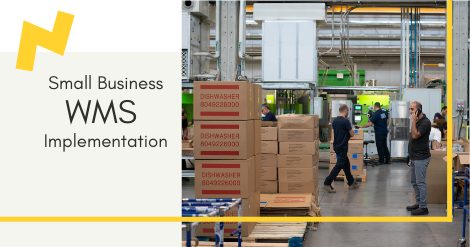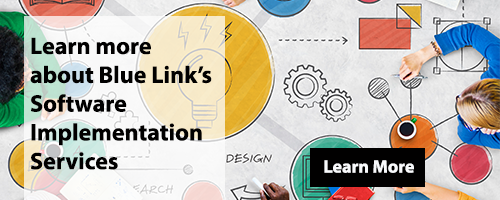Just like any implementation project, a small business WMS implementation takes a lot of planning and careful thought. Not only do employees need to learn how to use the software to do their job, but you may also have to set-up new processes in your warehouse (especially if you don’t currently have WMS software in place). This includes proper set-up of receiving, put-away, picking, packing and shipping and how you currently manage and store inventory. Essentially, WMS software creates a very fool-proof warehouse workflow by directing employees exactly where to go and what to do. There is no room for error as inventory is tracked at EVERY location. Dedicating adequate resources to the WMS implementation process will mean your warehouse is set-up as efficiently as possible from day one. Below we explore what a proper implementation looks like.
Creating a Master List of Locations
One of the main priorities of implementing WMS is to optimize your warehouse – in terms of bin and shelf locations, decoration, and processes. Therefore, at a very high-level, one of the first decisions you will need to make is around creating a Master List of Locations and properly organizing your warehouse. You will need to set-up each area of the warehouse as a designated location, keeping in mind the following:
- Is the location a stocking location or non-stocking location?
- Is the location human pickable?
- What is the Aisle, Bin and Shelf number?
- Is the location a cart, packing station, staging station or some other option?
- What are the dimensions of the location?
Once you have mapped out your warehouse, you will want to manage this information in a Master List of Locations (such as the example below).
Setting up Aisle, Bin and Shelf Labels
Labelling shelves (sometimes referred to as warehouse decorating) is an important step to a WMS implementation. Every location within your warehouse needs to have an Aisle-Bin-Shelf label with a barcode for scanning. This includes not only labels for the physical shelving, but you may also need barcodes for “Floor” locations (that you physically tape off with floor tape), “Wall” locations, “End-of-Aisle” locations, “Between Aisle” locations if you ever load product between aisles, etc. Lastly, you will also need non-stocking locations for mobile carts and forklifts and “Packing” location barcodes.
Pro Tip: Make sure BEFORE you print all your labels and barcodes, that you print and test a sample. This eliminates the risk of any issues with the barcodes not scanning and can save your company time and money. This is also a good opportunity to apply a barcode to one of your shelves to test the range of your scanners.
Barcode Product
Once you have determined that your labels and barcodes will scan, it is now time to barcode all of the product currently in your warehouse. This step is critical to the success of using WMS, because when you go live on the system, every time you interact with an inventory item, you will need to “move” the product into the appropriate WMS location, and this can only be done efficiently if you can scan the product to “move” it. Depending on the type of products you carry, you can choose to either have a barcode on the product itself or the shelf or bin that stores the product.
Pro Tip: During this stage, we recommend using a laptop and a portable printer on a cart to print product labels while you walk around the warehouse, moving from shelf to shelf. This task can take several weeks if not all products are already barcoded.
Prepare Hardware
At this point, you will need to start preparing all of your barcode scanning and Bluetooth devices. Part of this process involves making sure that you have full WiFi coverage in your warehouse. If there are any dead spots, you will want to investigate enterprise-grade WiFi devices. Part of this step includes:
- Pairing any Bluetooth scanners with the devices (assuming this is the type of scanning solution you decide on)
- Getting the devices on the WiFi network
- Loading the software (for example, Blue Link) onto the devices and configuring them to the right connections and network
- Training your warehouse managers on how to charge the device, how to login, how to establish the connection, how to scan, etc.
- If you will be locking up the devices every night, you will need to purchase a locking cabinet or find a room and set-up charging stations
Pro Tip: Make sure you have assigned one employee per shift who will be responsible for ensuring that every device is accounted for and is plugged in/charging every night. If you let all your devices run out of power, you will be completely down.
Training
Training is a very important aspect of the implementation process and involves separate scheduling and planning. Make sure that you ask about the training process when engaging with vendors to find out (a) if it’s included in the implementation process and costs and (b) who will be doing the training. At Blue Link, while the costs of training are always included as part of our implementation costs, we also work very closely with each customer to design a training plan that caters to their needs. When it comes to training, keep in mind the following:
- Is training done by the software vendor (and the same people involved with the other aspects of the implementation), or by a 3rd party?
- How tech-savvy are your users? Do they have experience using software, or will there be a big learning curve?
- What happens if you want more training after Go-Live?
Test Software and Go-Live
It is now time to start testing the software in preparation for your Go-Live date. Part of testing will also involve training staff on how to use the system and setting up different settings specific to your business – for example, configuring what order status will make orders show in the WMS as ready to pick. Now is when the software vendor will finalize that all the data is ready to go in the new WMS – including any open sales orders and active inventory items and pricing information, etc.
While the above gives a good snapshot of what a WMS implementation will look like, there are a lot of other detailed steps involved in implementing new ERP software with WMS capabilities. You will want to make sure that you spend the time properly vetting each software vendor about their specific implementation process before you sign any contracts.












